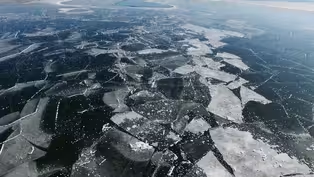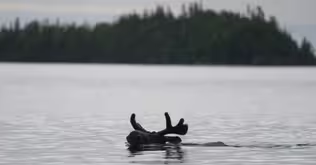
Salty Visitors
Clip: Season 3 Episode 10 | 8m 1sVideo has Closed Captions
Freighter pilots are helping to keep Great Lakes waterways, and other boaters, safe.
The Great Lakes Pilotage Act of 1960 requires all foreign vessels entering the Great Lakes for commerce use the services of a local pilot. Captain George Haynes has been a pilot for 27 years. He has piloted everything from Viking ships to luxury yachts but most often Captain Haynes can be found navigating ocean-going freighters through the Great Lakes.
Problems playing video? | Closed Captioning Feedback
Problems playing video? | Closed Captioning Feedback
Great Lakes Now is a local public television program presented by Detroit PBS

Salty Visitors
Clip: Season 3 Episode 10 | 8m 1sVideo has Closed Captions
The Great Lakes Pilotage Act of 1960 requires all foreign vessels entering the Great Lakes for commerce use the services of a local pilot. Captain George Haynes has been a pilot for 27 years. He has piloted everything from Viking ships to luxury yachts but most often Captain Haynes can be found navigating ocean-going freighters through the Great Lakes.
Problems playing video? | Closed Captioning Feedback
How to Watch Great Lakes Now
Great Lakes Now is available to stream on pbs.org and the free PBS App, available on iPhone, Apple TV, Android TV, Android smartphones, Amazon Fire TV, Amazon Fire Tablet, Roku, Samsung Smart TV, and Vizio.
Providing Support for PBS.org
Learn Moreabout PBS online sponsorshipFreighters from around the world come to the Great Lakes and to navigate these waters safely, they hire a local expert.
- When the St. Lawrence Seaway opened in 1959, it meant that ocean-going vessels with captains unfamiliar with the Great Lakes, would be sailing into these freshwater seas.
The Great Lakes Pilotage Act of 1960 required all foreign flagged vessels entering the Great Lakes use pilot services.
Captain George Haynes has been piloting ships on the Great Lakes for 27 years.
- To have a expert get these big ships in and out of the Great Lakes through all the different ports and waterways safely.
That's how all piloted authorities around the world pretty much work.
You become an expert in one geographic location.
It's a great job.
- It's a time-honored nautical tradition dating back to the ancient mariners to hire someone familiar with the local currents, shoals, tides and other hazards to ensure the safe passage of ships.
Bill Wager retired in 2021 after 44 and a half years as a dispatcher with the Lake Pilots Association.
It was his job to make sure that there was a pilot ready for every ship that needed one.
- Pilots were probably the second oldest occupation, you know 'cause somewhere somebody knew about tides and waters and oceans and currents.
And this is just a modern version of what's been going on for centuries in other parts of the world.
- Foreign vessels engaging in international trade on the Great Lakes must use the services of a Canadian or American pilot.
But any vessel can choose to hire a pilot.
- It's required by law, but it's also a good practice in that there's shallow waterways, narrow waterways, traffic situations that the crew may have never experienced before.
We can get quite a variety of different kinds of ships here too.
Most of the times we get bulk carriers that have these cranes in the middle.
But you get different lengths, different widths, different propulsion systems, different rudders, different propellers.
They can be loaded or unloaded.
- We used to do some cruise ships, but now it's an expanding industry.
We get yachts as well every summer.
They come up to the Great Lakes and spend several weeks and sometimes a couple, three months.
It's one of the favorite places for yachts to come.
- We pilot anything.
I've had some really cool tall ships over the years and even a Viking ship.
- The wide variety of vessels means Great Lakes pilots have to be ready and able to captain pretty much anything that floats.
The job starts as soon as they're assigned a vessel.
- I don't just wait before I get on board this ship to start thinking about the trip.
I'm researching the weather, the traffic, the conditions, everything.
Hours before, the night before even.
Coming out on the pilot boat, I observe the ship, I look at her drafts, I'm looking at crane configurations.
I'm looking at anything unusual that might affect the job.
Constantly absorbing information and calculating and figuring that into my transit.
- The freighters don't stop for the pilots.
Instead, a rope ladder is thrown over the side of the ship for them to board and disembark.
- When I get on board, I relieve another pilot.
He also tells me some things to look out for things that I need to know.
And then we're constantly gathering information as well.
Looking at the radars, radios, the electronic navigation, depth sounders, things like that.
Constantly gathering information and monitoring.
I talk to the captain, he tells me about the ship and what I need to expect.
- The pilot needs to know their current draft, if there are any equipment issues, and how fast they can drop an anchor.
While the ship's captain may ask for specifics about the passage or the time to the next pilot transfer.
- The captains are always in charge of their vessel, always.
But they also heavily listen to the pilot and and allow the pilot to navigate the vessel.
- Piloting services in the Great Lakes are divided into three districts.
The first starts at Montreal, and runs through Lake Ontario to the Welland Canal.
Bill Wager was a dispatcher with the second district which includes all of Lake Erie, and extends upstream to lower Lake Huron.
- We start tracking the ships at Montreal.
It's basically a day to get to Lake Ontario and then 10 hours across Lake Ontario and another 10 hours through the Welland Canal.
So somewhere between 42 and 48 hours would be the standard transit time to get from Montreal to where we become responsible for the ships.
- The third district is the largest covering all of Lakes Huron, Michigan, and Superior.
Freighters moving from one district to another, have to change pilots.
- We go out to the change point and our pilot goes up a rope ladder and then district three pilot will disembark and get his hotel room or get transferred to Chicago or Milwaukee or wherever he might be needed next.
- District two pilots like Captain Haynes board down bound vessels in Lower Lake Huron and navigate them to Detroit.
- Under the Blue Water Bridge is probably one of the most difficult spots of the St. Clair River.
- A team of dispatchers monitors vessel passages throughout the Great Lakes to ensure pilot services are available when needed.
But it's a fluid puzzle with dozens of moving pieces.
- If they don't get out of Toronto or Hamilton on time, and then there's heavy traffic in the canal.
If they had traffic at the Soo Locks.
A crane breaks down in Cleveland, it snows in Buffalo.
The puzzle gets rearranged a lot.
It's a challenge to keep the industry going and the pilots safe and in the right position for their next assignments.
You do everything you can think of, but when we're really busy, some ships have to go to anchor.
- Dispatchers arrange for car shuttles to transport the pilots to their next assignment or take them back home.
Other times they just book the pilots a hotel room.
- You'd like to see that pilot come home, have dinner with the wife and family, but the chances are maybe you're gonna use them in Cleveland tomorrow.
So maybe you put them in a hotel someplace.
We have people that are based in Cleveland, Detroit, and Port Huron.
It cuts down on travel.
If you're needed anywhere in our district that's where you go.
You happen to live in Port Huron and there's not a Cleveland man available for that ship out of Cleveland at night, okay, you're going to Cleveland, it's as simple as that.
- The Great Lakes are an important part of the global trade route, and pilots play a key role by helping to keep trade moving, whether it's grain bound for Europe and Africa, or potash headed to South America.
But the pilots' primary responsibility is the safety of the public and the Great Lakes' waterways.
- You got a lot of people waiting for these ships, they're waiting weeks or months for a cargo to come in.
And unfortunately it's my job many times to say no it's too unsafe to go.
And that it doesn't go over well with people on shore.
'Cause there's a lot of money riding on these.
We understand that.
We feel that pressure, we know that, but we also don't want to have an accident.
We actually are in the public interest.
We protect the environment, we protect system infrastructure, and we promote the smooth flow of commerce.
That's what pilots do.
We're keeping the waterways safe and other boaters too.
Video has Closed Captions
Clip: S3 Ep10 | 2m 57s | The Catch is GLN’s one stop shop for bite-sized news and events about the lakes you love. (2m 57s)
Video has Closed Captions
Clip: S3 Ep10 | 9m 40s | Visit a remote island where wolves and moose have been studied for more than 60 years. (9m 40s)
Providing Support for PBS.org
Learn Moreabout PBS online sponsorship
- Science and Nature

Explore scientific discoveries on television's most acclaimed science documentary series.

- Science and Nature

Follow lions, leopards and cheetahs day and night In Botswana’s wild Okavango Delta.












Support for PBS provided by:
Great Lakes Now is a local public television program presented by Detroit PBS

